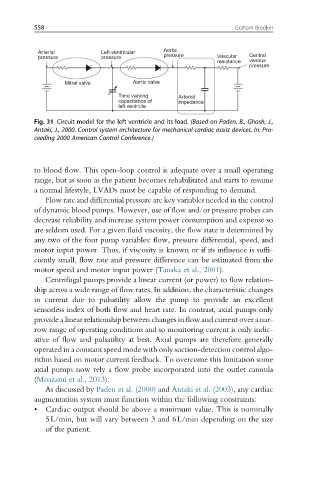Page 565 - Handbook of Biomechatronics
P. 565
558 Graham Brooker
Aortic
Arterial Left-ventricular
pressure pressure pressure Vascular Central
resistance venous
pressure
Mitral valve Aortic valve
Time varying Arterial
capacitance of impedance
left ventricle
Fig. 31 Circuit model for the left ventricle and its load. (Based on Paden, B., Ghosh, J.,
Antaki, J., 2000. Control system architecture for mechanical cardiac assist devices. In: Pro-
ceeding 2000 American Control Conference.)
to blood flow. This open-loop control is adequate over a small operating
range, but as soon as the patient becomes rehabilitated and starts to resume
a normal lifestyle, LVADs must be capable of responding to demand.
Flow rate and differential pressure are key variables needed in the control
of dynamic blood pumps. However, use of flow and/or pressure probes can
decrease reliability and increase system power consumption and expense so
are seldom used. For a given fluid viscosity, the flow state is determined by
any two of the four pump variables: flow, pressure differential, speed, and
motor input power. Thus, if viscosity is known or if its influence is suffi-
ciently small, flow rate and pressure difference can be estimated from the
motor speed and motor input power (Tanaka et al., 2001).
Centrifugal pumps provide a linear current (or power) to flow relation-
ship across a wide range of flow rates. In addition, the characteristic changes
in current due to pulsatility allow the pump to provide an excellent
sensorless index of both flow and heart rate. In contrast, axial pumps only
provide a linear relationship between changes in flow and current over a nar-
row range of operating conditions and so monitoring current is only indic-
ative of flow and pulsatility at best. Axial pumps are therefore generally
operated in a constant speed mode with only suction-detection control algo-
rithm based on motor current feedback. To overcome this limitation some
axial pumps now rely a flow probe incorporated into the outlet cannula
(Moazami et al., 2013).
As discussed by Paden et al. (2000) and Antaki et al. (2003), any cardiac
augmentation system must function within the following constraints:
• Cardiac output should be above a minimum value. This is nominally
5L/min, but will vary between 3 and 6L/min depending on the size
of the patient.

